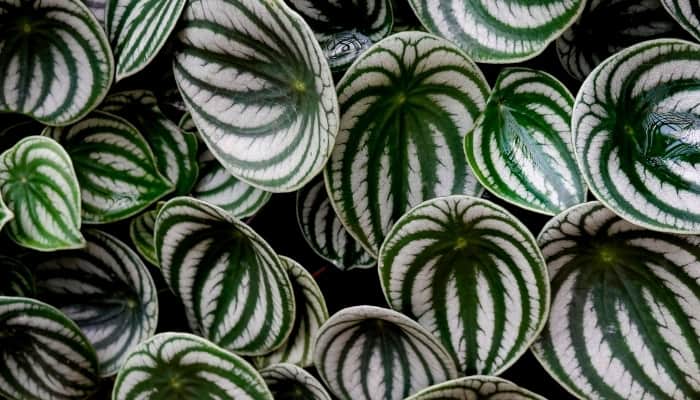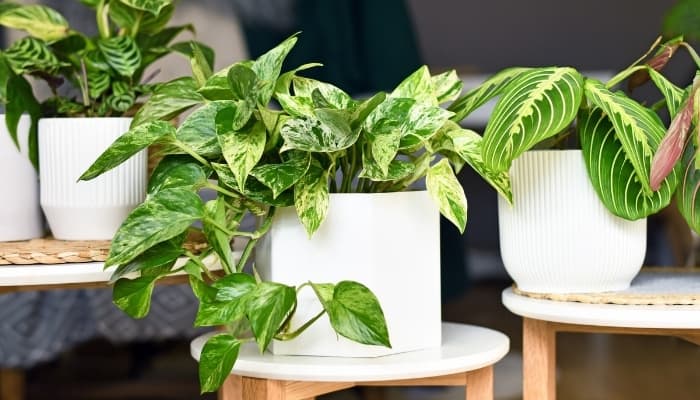Variegated plants are considered to have greater decorative appeal compared to solid-colored plants, however, it is rare to find plants with naturally occurring variegated leaves. The majority of ornamental plants sold at local nurseries are actually cultivated varieties.
In the following, we’ll detail the most common methods used to create variegation, and by the time you’ve reached the end, you’ll almost certainly have a greater appreciation for the beautiful swipes, streaks, stripes, and splashes of color that we all love.
Method #1: Chemicals To Interfere With Plant’s DNA
The idea behind using chemicals to induce variegation in plants relies on certain chemical compounds to degrade the chlorophyll production in the leaves, which can create random patterns of different shades of green, white, and even pink.
Most of the chemical applications are topical and require nothing more than spraying the leaves of the plant and waiting for the chemicals to do their magic.
Two chemicals are widely used to get these results. The first is ethyl methanesulfonate (EMS), which can be found in some herbicides including Roundup among others.
Ethyl Methanesulfonate
EMS is highly effective in not only inhibiting the plant’s production of chlorophyll (the compound responsible for the green color on the leaves) but can also cause existing chlorophyll to fade and wear off.
The use of EMS is highly regulated since it’s considered a carcinogenic material that damages not just the plant but any other plants, humans, or animals that get exposed to it.
Ethylene Gas
Ethylene gas is a much safer chemical option to induce variegation than EMS. It’s a naturally occurring plant hormone that helps fruits ripen.
Ethylene gas is topical and temporary just like EMS but when used in the right doses, it can change the color of the plant altogether.
With chemicals, you have no control over the pattern of the variegation or how long it would last.
In many cases, the variegation will go away once the chemical impact wears off and the plant resumes producing chlorophyll as normal. The maximum variegation time is usually 6 months.
If you want to maintain the variegation, you can apply the chemical over and over. You’ll get different patterns every time.
Method #2: Radiation To Alter Plant’s DNA
Radiation is a more invasive variegation method than chemicals. It’s also more complicated, costly, and less predictable than using ethylene gas, for example.
With radiation, horticulturalists expose the plant to high doses of X and gamma rays to interfere with the plant’s DNA and create mutations.
As with chemicals, the process is hard to control. While the right chemicals are guaranteed to change the color of the leaves, with radiation, the results are anything but.
For one thing, exposing the plant to radiation might create mutations that have little to do with the color of the leaves.
Instead, the plant might become stunted or stop producing flowers, or the leaves might grow smaller but still maintain their original colors.
In other words, radiation is not the ideal path to induce variegation in your plants. Besides the high cost and low accessibility, you’re more likely to kill the plant than get a few rings of pale color on the leaves.
Method #3: Introduce Virus
Nothing can play havoc with the plant’s DNA and induce mutations in the leaves like a virus. Viruses are notorious for disguising themselves as normal cells as they continue to multiply and destroy the plant’s texture from within.
However, when it comes to variegation, not all viruses will get the job done. You’re not looking to destroy the plant — you just want a little chlorosis.
Chlorosis is a change in the levels of chlorophyll on the leaves as a result of an infection. In most cases, the leaves will turn either partially or totally yellow.
Not all viruses can produce this discoloration in the leaves, and it only works on certain plants. Also, chlorosis is permanent, so if you don’t like the results, there’s no way to reverse them.
The most common viruses that cause variegation in plants are the following:
- Abutilon mosaic virus: The word “mosaic” in the name is a dead giveaway. The virus causes irregular patterns of white and yellow on the leaves of the Abutilon plants and the Chinese lantern tree. The higher the infection, the larger the discoloration.
- Honeysuckle yellow vein virus: This virus is more methodical in its approach to chlorosis. It creates a meticulous web of yellow veins on the leaves of the Japanese honeysuckle. Unfortunately, the virus doesn’t have the same effect on other plants.
- Tobacco mosaic virus: Another member of the mosaic family, this virus is more dangerous and affects far more plant species than the Abutilon mosaic virus. The patches are usually yellow but can be downright ugly.
Introducing a virus to your plant is a risky endeavor. Apart from the fact that the results might not be visually appealing, you also put the health and well-being of the plant in danger.
The virus might cause irreparable damage to the plant, cause ugly deformations, or might kill the plant in the process — not to mention that you risk spreading the virus to other plants in the garden.
Method #4: Propagate Plants With Blister Variegation

If you don’t like to change the plant’s DNA to create unpredictable and temporary changes to the surface of the leaves, then you can try growing plants where variegation occurs naturally.
Some plants such as certain begonias, lungworts, and Anthuriums have variegated leaves that have little to do with chlorophyll degradation. It’s called blister variegation.
Blister variegation presents itself as pockets of air under the epidermis with the upper layer lacking chlorophyll.
When these hairs or pockets of air catch the light they reflect different shades of silver and white. These effects are permanent and don’t impact the pigmentation of the leaves themselves.
Moreover, these genetic traits are inherent in the plant, which means that propagating the plant from seeds or cuttings will produce new plants with the same variegation properties.
This method is probably one of the safest and least invasive variegation methods you can use. It doesn’t require special equipment and it won’t cost you more than the price of the seeds.
Since you’re not changing the plant’s DNA or creating mutations, no harm will come to the variegated plant or any other plants around it.
Method #5: Use Certain Antibiotics
Using antibiotics to produce variegated plants is a fairly new field of study with little research to back it up.
The few studies that tackled this subject showed promising results when using streptomycin. This method is similar to using chemicals such as EMS to induce mutations in the plant.
Besides its inaccessibility to the average gardener, using antibiotics poses an environmental hazard. It can help create strains of bacteria that are resistant to the current antibiotics, making them harder to kill.
So, as novel as this method may sound, it’s neither the best approach to induce variegation in plants nor is it the safest one.
Method #6: Genomic Sequencing
As if exposing plants to radiation or feeding them antibiotics wasn’t complex enough, this method takes the cake in terms of complexity, cost, and the extensive time it takes to perform.
Genomic sequencing, as the name implies, involves picking bits and pieces of the genes of the plants and rearranging them to change the properties of the plants. Your goal is to create a plant with just variegated leaves.
That might sound like overkill, but those with the right resources, time, knowledge, and experience think it is worth pursuing. There are a few studies that show that such a process can be performed on plants with varying degrees of success.
Method #7: Cross-Breed Plants That Possess the Trait
Cross-breeding plants is an ancient pastime. Sometimes it’s done for fun to create new cultivars, and sometimes it is done to create new plants that are more resistant to disease, have more or fewer seeds, or produce more delicious fruits.
It’s easy enough that anyone with a lot of time on their hands can do it in their backyard or even on the balcony.
If you want to cross-breed plants to induce variegation, then you’ll need to use a plant where variegation occurs naturally along with the plant you want to have variegated leaves.
As easy as this may sound, the results are highly unpredictable. There’s no guarantee that the new cultivar will have variegated leaves — not to mention that you might end up with other unforeseen or undesired qualities in the new cultivar.
Moreover, like many other cultivars, the chances of maintaining the variegation traits when propagating it either from seeds or a cutting are very minimal. The new traits might be lost once the plant perishes.
Conclusion
Inducing variegation in plants can be achieved with chemical treatment, by triggering mutations, by rearranging the genes, or simply by cross-breeding two plants where one of them is naturally variegated.
Some viruses cause chlorosis in certain plants, but that can be harmful to the plant and any other plants in its vicinity.
For most hobbyists, it’s a whole lot easier to simply enjoy the hard work of others and focus on keeping the variegated plants you already have as healthy and happy as possible.

